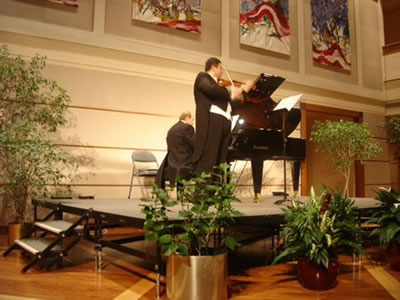Violinist Tibor Kovac and Pianist Lambert Orkis
By Cecelia Porter
A notable highlight of the Embassy’s numerous cultural events was the concert by Tibor Kovac of the Vienna Philharmonic and pianist Lambert Orkis, organized by the Austrian-American Society in cooperation with the Austrian Embassy’s Cultural Forum which took place on March 5 in the Embassy. Austrian Information is happy to bring an enthusiastic review by The Washington Post’s classical music critic, Cecelia Porter, of this memorable evening.
The recital at the Austrian Embassy on 5 March by internationally acclaimed violinist Tibor Kovac and the distinguished pianist Lambert Orkis was remarkable in many ways. Playing works of Mozart, Beethoven, and Prokofiev, they were both sensitive and virtuosic partners. Kovac is a longtime member of the Vienna Philharmonic. Orkis has won renown as a pianist, fortepianist, and harpsichordist. Both artists are recognized as stunning soloists, chamber music players, and orchestral performers. For a single musician to excel in all these capacities is a rare phenomenon. Both Kovac and Orkis are also devoted teachers and have numerous recordings to their credit.

Tibor Kovac's and Lambart Orkis' concert at the Austrian Embassy
The March concert, a memorable one, was exciting, luminously warm, and all-embracing. (This was all the more remarkable because Kovac had just played three Vienna Philharmonic concerts in New York the previous weekend. And Orkis had come to the embassy as part of an equally crowded schedule). Not only technically, but also in style and soul, both players were in complete accord throughout the evening, Orkis listening and responding to Kovac’s every nuance from moment to moment. As always, Kovac’s sublimely radiant tone resounded with utter sweetness and sheer energy, his sound-blending lyricism with nostalgia - a not unexpected timbral combination unique to Vienna’s particular complex of ethnic and national cultures. (For the March concert, Kovac had been playing his wonderful Stradivarius, dating from 1724, for only one month.)
Judging by the transporting beauty of their program, one could never guess that these performers had faced obstacles in preparing this concert, obstacles that would have easily raised many performers anxiety level. As Kovac remarked in an interview a day after the concert, “I had never met Orkis until now.” “And time,” he added, “allowed us only a single rehearsal.” In addition, as the duo began to rehearse the Beethoven, Kovac waited for the piano introduction while Orkis listened for the violin entrance. Kovac then “realized,” he said, “that we were expecting to play two different pieces. I had supposed it was the Sonata in C Minor, Op. 30, No. 2, while Lambert had programmed the one in D Major, Op. 12, No. 1, which I had never performed. So after our practice, I spent three hours analyzing and playing the one in D Major.”
Two intriguing and imaginative works by Wolfgang Amadeus Mozart opened the recital: the Sonata in B-flat Major, K. 454, and that in E-flat Major, K. 481. Both pieces offer subtle challenges that Kovac and Orkin met with sensitivity and sophistication. The first movement of K. 454 - an elegant Largo in recitative style leading to an exciting Allegro - was played with fervor laced with operatic élan; the Andante moved along in a languorous dialogue, one of total sweetness and light. The sonata was capped by a vigorous finale.
In the second Mozart, K. 481, the musicians gave wide scope to the composer’s uncanny sense of thematic development - both melodically and harmonically - doing so with assured singleness of mind in phrasing and balance. This quality, in fact, was much in evidence during the entire evening. And the Adagio could not have been more impassioned. During the final movement, which was marked by boldly intensifying brilliance, Kovac’s E-string suddenly snapped, he later remarked, “untuning my remaining three strings. As a result, I had to instantly shift to different fingering and adjust my touch on those strings in order to play all the notes that Mozart called for”. He did this and did it seemingly instantaneously, triumphantly finishing the sonata. As Kovac humorously added, “But, as a result, I was forced to rely solely on the replacement string for the rest of the concert.” “I had to make it through the Beethoven and Prokofiev without any spare E-strings. But I made it.”
In the Beethoven, the musicians gave voice to that monumental symphonic breadth that suffuses even the composer’s chamber works. The ecstatic Allegro con Brio rippled along with rapture tempered by grace, never losing the essence of the principal thematic idea that Beethoven subjected to continual structural transformations. At the same time, the performers’ approach was one of spirited freshness through to the last measure. The concluding Rondo was marked by a hint of the heroic cast in an ebullient bravura.
The performance closed with composer Sergei Prokofiev’s fiery Sonata in D major, Op. 94, for flute and piano from 1943. The work was transcribed a year later for violin and keyboard as Op. 94bis. Kovac and Orkis treated the Prokofiev with epic, majestic expansiveness-invoking visions of the vast Russian steppes themselves-and with that thrusting boldness so genuinely characteristic of much of the composer’s music, notably his approaches to operatic writing and orchestral style. The statuesque opening movement was propelled by visionary fury, while allowing the central repeated-note figure to unfold in molten fluidity through many guises. After the exuberant Scherzo, the Andante brought luminous melodiousness and aching, even throbbing expression. The closing Allegro proceeded passionately, yet was flavored with grotesque, ultra-Prokofievan irony.
Not surprisingly, the audience demanded an encore. Kovac and Orkis offered Fritz Kreisler’s well-known “Liebesleid,” performed with breathtaking delicacy, intimacy and a gentle feeling of reminiscence rather than the pretentious exhibitionism too often displayed by less knowing performers.
Cecelia Hopkins Porter is a classical music critic for The Washington Post and has written articles for numerous publications.
